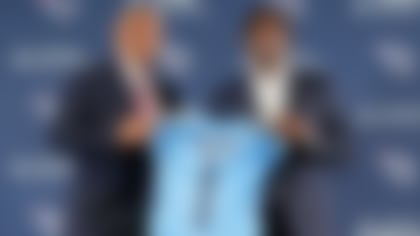By now, most of you have probably seen the great hustle play by New Orleans Saints safety Malcolm Jenkins, who ran down Tampa Bay Buccaneers receiver Vincent Jackson on a 95-yard pass play, tackling him just before the goal line. While that moment was obviously the turning point in the Week 7 matchup, I want to discuss the coaching decisions that led to the four subsequent goal-to-go plays.
At the time, the Bucs were trailing 28-21 midway through the third quarter and had a first-and-goal from the 1-yard line. Tampa Bay handed it off to LeGarrette Blount for three straight between-the-tackles running plays. Blount lost one yard on the first carry, gained one yard on the second and gained none on the third. On fourth-and-goal, the Bucs elected to roll quarterback Josh Freeman out to the right, but his tight end was covered in the end zone and he was tackled for a loss of four yards.
Some questioned Buccaneers coach Greg Schiano's decision to go for it on fourth down rather than take the easy field goal, as well as his decision to run the ball three straight times. But I whole-heartedly agree with what he did; going for it on fourth down was the correct move.
Strategic choices like these need to be made on a case-by-case basis, and the circumstances of the game itself must be considered. In this case, the Bucs were playing a red-hot Saints offense; New Orleans quarterback Drew Brees had thrown for 313 yards in the first half alone. Schiano likely figured he would need to keep up with Brees in a shootout; the Bucs weren't going to get it done substituting field goals for touchdowns.
The St. Louis Rams tried to do the same thing on Sunday against Aaron Rodgers and the Green Bay Packers. The Rams were trailing the Packers, 10-3, and facing fourth-and-2 from the Green Bay 14 early in the second quarter when Rams coach Jeff Fisher elected to go for it. Quarterback Sam Bradford failed to connect on a quick slant with Brandon Gibson. Although the results didn't go his way, Fisher was implementing the same theory as Schiano: We are going to need to keep pace with an explosive offense, so we need seven points, not three.
Goal-line football is similar to the penalty kick in soccer. The goalie must decide before the kick whether he is going to dive high or low, right or left. If he waits to react to the kick, it will be too late. Goal-line defenses in the NFL often face the same sort of situation. Coaches must decide ahead of time whether they'll sell out to stop the run or be ready to spread out and defend the pass.
This guessing game often leads coaches to play chess with each other. For example, if I'm coaching a team and we have a first-and-goal from the opponent's 1-yard line, the defense likely assumes I'm going to run the ball. So I'll pass instead, figuring they'll sell out to stop the ball carrier. Or if, like the Bucs, my team had just been stuffed on two straight running plays up the middle, the defense likely expects me to pass on third down. So instead, I'll run it one more time in an attempt to catch them guessing. And that's what the Bucs did.
Coaches often try to do the opposite of what they think is expected of them, to take advantage of a defense playing the odds. That strategy didn't work for Schiano on Sunday, but that doesn't mean it wasn't the right call.
OTHER OBSERVATIONS
» The combination of skills that Carolina Panthers quarterback Cam Newton possesses makes it hard to understand his red-zone struggles. This season, Newton has just as many interceptions as he does completions in goal-to-go situations: two. Much of the blame for that statistic can be placed on the play calling. For example, against the Dallas Cowboys on Sunday, Newton dropped straight back in the pocket, surveyed the field, saw pressure coming and was picked off when he tried to throw the ball away. But why was he dropping straight back to begin with? With his athleticism and running power, the Panthers should always give him a run-pass option on a roll-out. That would allow Newton to take advantage of his best assets and also cut the field in half on his read, making it easier for him to decipher the coverage and limit his throwing errors.
» After watching Randall Cobb play in person again on Sunday, I'm convinced he can be the same type of player for the Green Bay Packers that Percy Harvin is for the Minnesota Vikings. Especially considering how the Packers have struggled with the run, I anticipate seeing him more out of the backfield, with the Packers trying to get him the ball in space via screens and arrow routes.
Brandt: Biggest of big men
Linemen are important but oft-forgotten. Gil Brandt gives them some love, naming the top talent on both sides of the ball. **More ...**
» Despite playing an Indianapolis Colts team that had just surrendered 252 rushing yards to the New York Jets in Week 6, the Cleveland Browns totaled just 55 yards on the ground Sunday. Even with that low total factored in, the Colts have given up 141.7 yards per game on the ground, 26th in the NFL. So why did Browns quarterback Brandon Weeden attempt 41 passes? Even if rookie running back Trent Richardson's injury was more serious than people knew, Cleveland still had a capable backup in Montario Hardesty and an offensive line that is built to dig out lanes in the trenches. Running the ball just 17 times -- and one of those times was a Weeden scramble -- against one of the league's worst rushing defenses is hard to accept.
Follow Brian Billick on Twitter @coachbillick.




